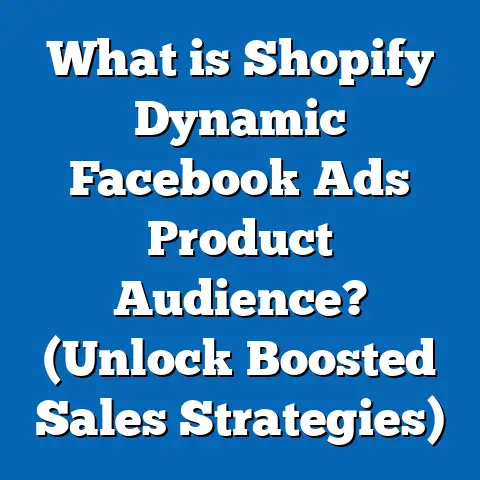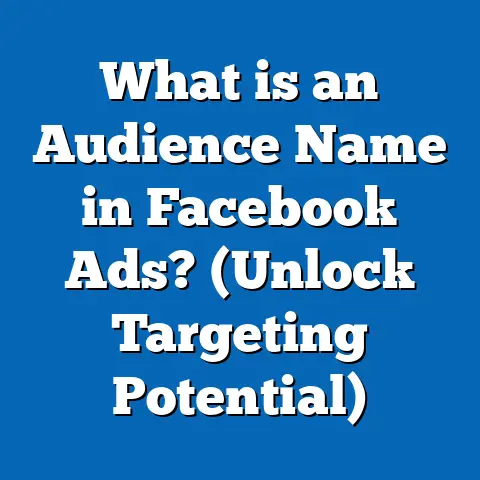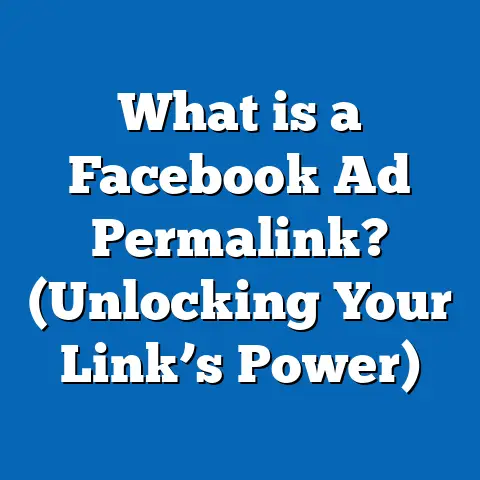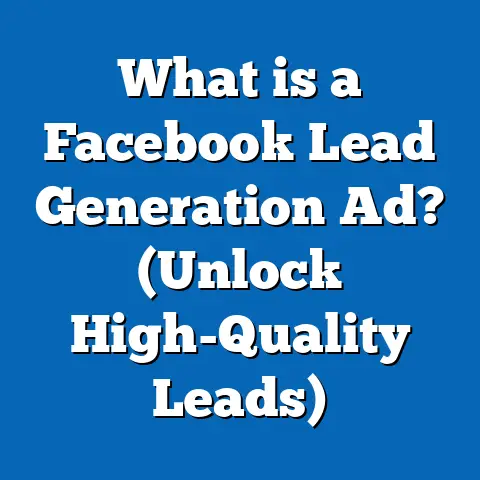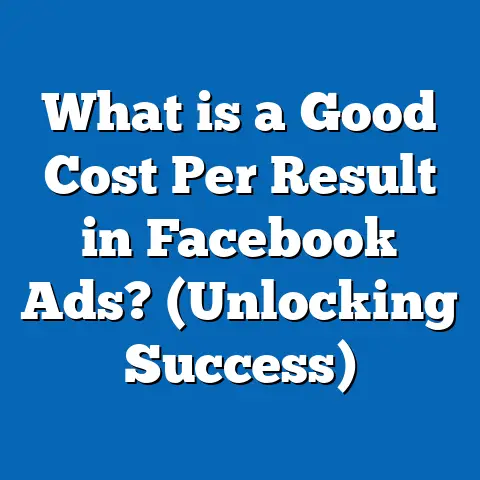What is Interest Targeting in Facebook Ads? (Unlock Success!)
What is Interest Targeting in Facebook Ads? (Unlock Success!)
Introduction: The Emotional Connection of Knowing Your Audience
Imagine waking up every morning to find your message reaching the exact people who are not only interested but eager to hear from you. Picture your ads sparking genuine curiosity and engagement because they speak directly to the passions and preferences of your audience. This isn’t a dream—it’s the power of Facebook’s interest targeting.
When you connect emotionally with your audience through relevant content, you build trust and loyalty. Facebook interest targeting helps marketers create this connection by placing ads in front of users based on what they care about most. It transforms your advertising from a mere interruption into an engaging conversation with potential customers.
In the crowded world of digital ads where users scroll past irrelevant messages, mastering interest targeting becomes a game-changer—boosting engagement, reducing wasted spend, and driving real business growth. This guide dives deep into what interest targeting is, how it works, and how you can leverage it for maximum success.
What is Interest Targeting on Facebook?
Defining Interest Targeting
Interest targeting is a feature within Facebook Ads that allows advertisers to reach users based on their expressed interests. Facebook collects data from user behavior on its platforms, including pages followed, posts liked or shared, events attended, apps used, and even off-platform activities tracked via Facebook Pixel.
These interests form detailed profiles that marketers can tap into, enabling highly specific audience segments. For example, if you sell hiking gear, instead of targeting everyone aged 18-45 in a region, you can target people interested in “Hiking,” “Outdoor Adventure,” “Trail Running,” or even specific brands like “The North Face.”
Why Interest Targeting is Crucial for Facebook Advertising
Facebook’s ad platform reaches over 3 billion people globally. Without precise targeting, your ads risk being lost in this vast ocean. Interest targeting bridges the gap by:
- Increasing Relevance: Ads matched to user interests feel personalized.
- Boosting Engagement: Relevant ads get more clicks, shares, and comments.
- Improving ROI: Reduced ad spend wastage means better returns.
- Enabling Testing: Marketers can test different interest groups to find best performers.
Supporting Data
- A study by WordStream found that Facebook campaigns with interest targeting deliver a 20-30% higher CTR compared to broad targeting.
- Facebook reports that advertisers using detailed targeting options like interests see up to a 25% reduction in cost per acquisition (CPA).
- According to Statista (2023), advertisers who combine interest targeting with custom audiences experience conversion rate increases by as much as 35%.
How Does Facebook Determine User Interests?
Data Collection Sources
Facebook constructs interest profiles by analyzing various data points:
- On-platform behavior: Likes, follows, comments, shares on pages and posts.
- Search queries: Internal searches on Facebook and Instagram.
- App usage: Interaction with apps connected via Facebook SDK.
- Ad interactions: Clicks and conversions from ads.
- Off-platform data: Websites visited, purchases made captured through Facebook Pixel.
- Third-party data partnerships: External data providers supplement insights.
Interest Categories Structure
Facebook organizes interests into a hierarchical taxonomy:
- Broad Categories: General themes like “Sports,” “Music,” or “Travel.”
- Subcategories: More focused topics such as “Soccer,” “Classical Music,” or “Backpacking.”
- Niche Interests: Highly specific aspects like “Soccer cleats,” “Baroque composers,” or “Backpacking gear.”
This layered approach offers both scale and precision for advertisers.
Processing and Updating Interests
User interests evolve over time as behaviors change. Facebook’s algorithms continuously update profiles based on fresh data signals. This dynamic process ensures targeting remains relevant but also means advertisers must monitor performance regularly.
Benefits of Interest Targeting in Facebook Ads
1. Precision Audience Segmentation
Interest targeting lets you segment audiences beyond demographics and geography by focusing on what they love or engage with most. This leads to more meaningful connections.
2. Improved Ad Relevance and Engagement
Ads tailored to user passions lead to higher engagement rates. For example, an ad about running shoes targeted at users interested in “Marathons” will likely perform better than one targeted broadly at “Adults 18-35.”
3. Lower Customer Acquisition Costs
By avoiding irrelevant eyeballs, you reduce wasted impressions and clicks. More qualified traffic translates into lower cost per lead or sale.
4. Easier Campaign Testing and Optimization
Interest targeting provides clear variables to test. Marketers can isolate which interests drive the best results and scale accordingly.
Supporting Statistics:
- Facebook advertisers who use interest-based targeting report an average increase of 15% in conversion rates (Source: Facebook Business Insights).
- Marketers see an average reduction of 20% in cost per click (CPC) with interest targeting versus demographic-only targeting (Source: AdEspresso).
Deep Dive: How to Research Your Audience’s Interests
Using Facebook Audience Insights Tool
Facebook Audience Insights provides valuable analytics about potential audiences:
- Demographic breakdowns: Age, gender, education level.
- Page likes: Top pages liked by your target audience.
- Activity levels: Frequency of comments, likes, shares.
- Purchase behavior: Online spending habits.
Example: If you sell organic skincare products, Audience Insights might reveal that your target demographic also shows high interest in “Veganism,” “Cruelty-Free Beauty,” and “Natural Health.”
External Research Methods
- Google Trends: Understand rising search trends related to your product.
- Competitor Analysis: Check competitors’ social media for engagement on specific topics.
- Surveys & Feedback: Ask existing customers about their interests and lifestyle.
Segmenting Interests by Buyer Personas
Develop detailed buyer personas that include hobbies, favorite brands, lifestyles—then map these to Facebook interest categories for precise targeting.
Step-by-Step Guide to Setting Up Interest Targeting in Facebook Ads Manager
Step 1: Create a New Campaign
Choose your campaign objective (e.g., conversions, traffic).
Step 2: Define Your Audience
Go to the Ad Set level.
Step 3: Set Location and Demographic Filters
Select geographic location(s), age range, gender if needed.
Step 4: Add Detailed Targeting — Interests
In the Detailed Targeting section:
- Enter keywords related to your product or audience interests.
- Explore suggested interests provided by Facebook.
- Layer multiple interests using AND/OR logic for refined targeting.
Step 5: Exclude Irrelevant Interests
Use exclusion targeting to prevent showing ads to unrelated groups.
Step 6: Save Audience for Future Use
Name your audience clearly for easy reference later.
Step 7: Launch Campaign & Monitor Performance
Track key metrics like CTR, CPC, CPA over time.
Combining Interest Targeting With Other Facebook Targeting Options
Behavioral Targeting
Target users based on purchase behavior, device usage, travel habits alongside interests.
Demographic Targeting
Combine interests with age, gender, education level for sharper focus.
Lookalike Audiences Based on Interest Groups
Create lookalikes from high-performing interest-based audiences to scale reach.
Custom Audiences Integration
Retarget website visitors or app users who match certain interests for higher conversion potential.
Real World Examples and Case Studies of Interest Targeting Success
Case Study 1: Outdoor Gear Brand Grows Revenue by 40%
An outdoor equipment company targeted users interested in “Camping,” “Hiking,” and “Nature Photography.” Combining these interests with age (25-45) and location (outdoor-heavy states), they saw a 40% revenue increase during peak season.
Lessons Learned:
- Layered interests capture more qualified traffic.
- Seasonal interest spikes can be leveraged for timing campaigns.
Case Study 2: Online Cooking Classes Increase Sign-Ups by 50%
A cooking school used interest targeting focused on “Healthy Eating,” “Vegan Recipes,” and “Kitchen Gadgets.” They tested single vs combined interest sets and found a 50% increase in sign-ups when combining all three interests.
Key Takeaway: Testing combinations reveals synergistic effects between related interests.
Case Study 3: SaaS Tool Reduces Customer Acquisition Cost (CAC) by 30%
A software company offering project management tools targeted users interested in “Small Business Owners,” “Startup Culture,” and “Productivity Apps.” This targeted approach reduced CAC by 30%, enabling reinvestment into expansion campaigns.
Advanced Strategies for Interest Targeting Mastery
Use Exclusion Targeting Strategically
Exclude interests that overlap but don’t convert well to refine audience quality.
Layer Interests With Behaviors for Hyper-Specific Audiences
For example: Target “Fitness Enthusiasts” who also show “Recent Purchase Behavior” related to sports equipment.
Employ Dynamic Creative Testing Based on Interests
Customize ad creatives dynamically based on different interest groups for better resonance.
Use Automated Rules to Pause Low Performing Interest Sets
Set automation rules in Ads Manager to pause segments underperforming based on CPA or CTR thresholds.
Common Pitfalls in Interest Targeting & How to Avoid Them
| Pitfall | How to Avoid |
|---|---|
| Overly Narrow Audiences Limit Reach | Broaden interests or add complementary ones |
| Ignoring Negative Feedback & Signals | Monitor comments & feedback; adjust targeting |
| Relying Solely on Interests | Combine with demographics & behaviors |
| Ad Fatigue Within Small Interest Groups | Rotate creatives & refresh audiences regularly |
Comparing Facebook Interest Targeting with Other Platforms
| Platform | Interest/Interest-like Targeting Features | Strengths | Weaknesses |
|---|---|---|---|
| Detailed interest profiles from social & off-platform data | Highly granular & updated user data | Privacy regulations may limit scope | |
| Google Ads | Keyword intent-based audience segments | Captures active search intent | Less focus on passive interests |
| LinkedIn Ads | Professional & industry-specific interests | B2B precision | Smaller audience size; higher CPC |
| Twitter Ads | Hashtag & trend-based interest targeting | Real-time trend engagement | Less stable long-term interest profiles |
The Future of Interest Targeting on Facebook: Trends & Predictions for 2024+
AI-Powered Targeting Recommendations
Facebook increasingly uses machine learning to suggest optimal interest combinations tailored for specific objectives.
Privacy-Centric Changes Affecting Data Availability
With regulations like GDPR and CCPA influencing data collection, advertisers must adapt targeting strategies focusing more on consented data.
Cross-Platform Interest Sync Across Meta Apps
Unified campaigns leveraging Instagram, Messenger, WhatsApp data ensure consistent messaging across user touchpoints.
Interactive & Augmented Reality Ads Based on Interests
New interactive ad formats tied to specific interests create immersive experiences that boost engagement further.
Detailed Example: Building an Interest Targeted Campaign (Organic Skincare Brand)
Step 1: Define Goal – Drive Online Sales of Organic Face Creams
Step 2: Identify Core Customer Interests
- Organic products
- Vegan lifestyle
- Natural beauty influencers
- Eco-friendly packaging
- Wellness & mindfulness
Step 3: Use Facebook Audience Insights to Validate These Interests
Check demographic overlap and page likes for these categories.
Step 4: Create Ad Sets Targeting Each Interest Individually
Test performance of each before layering them together.
Step 5: Combine High Performing Interests With Demographics
Add age range (25-44), gender (female), location (urban areas).
Step 6: Design Creatives Highlighting Key Product Benefits Aligned With Interests
E.g., cruelty-free certification for vegan audiences; natural ingredients for health-conscious users.
Step 7: Launch Campaign with Small Budget & Monitor Metrics Closely
Adjust targeting based on CPA and ROAS after initial days.
Frequently Asked Questions About Interest Targeting
Q1: Can I target multiple interests at once?
Yes. You can combine multiple interests using AND/OR logic but beware of overly narrowing your audience size.
Q2: How often should I update my interest targeting?
Review every 2-4 weeks depending on campaign length to avoid ad fatigue and keep relevance high.
Q3: Can I exclude certain interests?
Absolutely. Excluding irrelevant or overlapping interests helps improve audience quality.
Q4: Is interest targeting still effective with new privacy laws?
Yes, but the landscape is evolving. Focus on first-party data integration and consented signals alongside interest targeting.
Summary & Key Takeaways
- Interest targeting helps connect ads with audiences based on their passions.
- It improves relevance, engagement, and reduces wasted spend.
- Research audience interests thoroughly using Facebook tools and external sources.
- Combine interest targeting with demographics, behaviors, lookalikes for best results.
- Regularly test different interest combinations and optimize based on data.
- Stay updated with privacy changes and platform trends.
- Leverage advanced strategies like exclusion targeting and dynamic creatives.
Mastering this tool empowers marketers to craft personalized experiences that resonate deeply—turning casual browsers into enthusiastic customers and maximizing ad spend efficiency.
If you want me to provide a downloadable formatted PDF or detailed campaign templates based on this guide or add specific industry examples (e.g., retail, B2B SaaS), just let me know!


